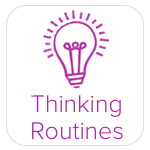- STEP 1: To begin have all students stand in a circle. Go around the circle allowing students to take turns giving a suggestion of a physical activity that all students can do (brainstorming a list of possibilities is a good idea the first time you try this to avoid wait time between students). c (i.e.: Over the summer, I. .. )
- STEP 2: Set up parameters about use of space (all done in self space) and physical limitations of students (you may be able to do a handstand but I can’t!) as well as a time limit (like having the students count to 5 while they perform the movement).
- STEP 3: The first student might say, “Let’s do jumping jacks” and the class responds in unison, “Yes, let’s!” Students can count to 5 in unison as they perform the jumping jacks. The next student then offers an idea like, “Let’s be fish swimming underwater” and again the class responds, “Yes, let’s!” and performs the movement while counting to 5 (or repeating “glub” 5 times!).
- STEP 4: As a whole class give the students a role in a scenario. Perhaps they are architects building a mansion for a famous athlete (“Since he is a basketball player we should build a basketball court” says the first student.
- STEP 5: The next student adds on to the first statement by saying.. Yes, and ….. For example: “Yes, and we should build a track around the outside of the court so he can run. “).
- STEP 6: As students become familiar with the strategy you may be able to break them into smaller groups or pairs and give them scenarios to try out or allow them to brainstorm their own scenarios. These can be as realistic as making plans for after school or as fantastic as planning a voyage to outer space.
 |  |  |
